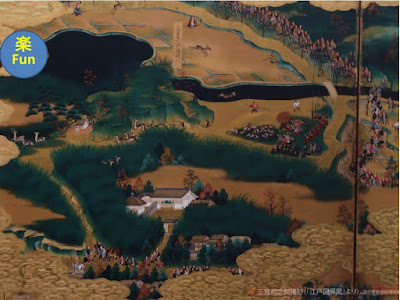The museum is by the Sanpouji pond which is the head of Shakujii River. The ground water outwells here. 石神井川の水源、三宝寺池の畔に文化館はある。地下水が湧き出ている。
Museum、会議室などもある立派な建物だ
The museum is located at Nerima ward of Tokyo which is a very
popular residence area now, although it was an agricultural area in the Edo period (1603~1868).
The specialty is Nerima radish. Exhibits show us
their lives well.
I went there to see the special exhibition “Driving disease away
- Medical knowledge and technique in the Edo period”. It was held before covid-19 pandemic.
練馬区は人気の住宅地ですが、江戸時代は、郊外の農業地帯。名物の大根生産など、人びとの暮らしが良く分かる展示でした。お目当ては、特別展の「病退散ー江戸の知恵と医術」、コロナウイルス蔓延の今年を見通したような企画です。
Permanent exhibition、常設展
The room is as large as four classrooms.
常設展示室は、教室3~4個相当でかなり広い。
Ancient era、縄文時代
This area is named “ancient people gathered at the outwell place.” Accessories are exhibited. Women want to dress up all the time. The clay face (upper left) which was attached at a handle is very rusty. It's nice.「湧き水に集う縄文時代の人びと」のコーナーでは、アクセサリー類が展示されている。おしゃれしたい気持ちは変わらない。把手の装飾に使われた顔が、何ともユニーク。
Japanese radish、大根
The specialty of Nerima is a Japanese radish.The process of pickled radishes and dried radishes are exhibited.
People sold them at Edo (Tokyo) and bought books and clothes there.
練馬と言えば、大根。
大根を使った「たくあん漬け」や干し大根のモデルと工程が展示されている。
練馬で作った農作物を江戸・東京に売りに行き、下肥や書籍・衣類などを買って帰ったという。
Radish farmers seem to be very happy.
大根農家の人たち。笑顔が良い
Process of making pickled radishes and
dried radishes
たくあん漬けや大根干しの様子。右下は大根洗い。
The radish dish has been popular since the Edo period. Processed radishes were transported to Edo.
そして、大根料理は江戸時代から人気だったようだ。干し大根やたくあん漬けで江戸に送られた。
Rice farming、稲作
Preparation of soil
米ももちろん作る。代掻き作業。
Threshing、脱穀作業
Wheat farming、麦作
They made udon noodle or cakes from wheat.
麦も作る。麦から、うどんやおまんじゅうを作る
Cuisine of the special event such as a festival and Bon ritual.
Cakes (buns) for breakfast, udon noodle for lunch, white rice and vegetables for dinner.
Before the WW2, people usually ate barley rice, vegetable and miso soup. It was so simple.
「朝まんじゅう、昼うどん、夜は田んぼの白い飯」。盆や祭りなどの特別な日の食事。
戦前の通常の食事は、麦飯を主食に漬物などの副菜、味噌汁だったという。
Farmers’ Life in Nerima、練馬の暮らし
The house was surrounded by trees which blocked strong winds.Trees also provided firewood and leaves which were used as fertilizer.
家の周りの屋敷林は、風よけだけでなく、薪や炭という燃料、落ち葉や下草などの肥料の原料供給源であった。
People in Edo visited shrines and temples
near the pond.
The old picture depicts that someone took a break by the cropped
radishes and showed something to the travelers.
三宝寺池周辺や社寺には江戸の人々が訪れたという。
江戸名所図会(1834~1836年)に描かれた石神井神社。収穫した大根の横で休んでいる人、箸で何かをさしだしている。
The shogun also visited Nerima for
hunting.
Many people watched the boar hunting of the third shogun Iemitsu
Tokugawa.
I think it was an exciting spectacle for locals.
将軍も狩猟のために練馬を訪れた。江戸図屏風に描かれた家光の猪狩りの様子。勢子かも知れないが沢山の人が柵の外から見物している。
地元の庶民にとっても、大イベントだ。
Reference (deer hunting by the shogun in Chiba area): O-shishigari お鹿狩り
You can touch old style agricultural tools
here.
農機具の体験コーナー
Inherited culture、「受け継がれた文化」のコーナー
Folklore items such as festival outfit are exhibited.There are 17 music bands in Nerima in 2009, because the samurai officer Mr. Ina encouraged them. What a cool man!
大黒舞の衣装など民俗関係の展示がされている
練馬には、祭り囃子を演奏する囃子連が17チーム(2009年)ある。
関東代官・伊奈半左衛門が奨励したので広まったそうだ。粋な人だ。
It says that the kou is a mutual aid organization in a village. It is a spiritual base of villagers and is an enjoyable event.
It also says that there were various kous.
Members of kous went to Mt. Fuji, Mt. Oyama, other shrines and temples which were regarded to agriculture.
There were another kind of kous which were held on the fixed days, such as Inari-kou and Koushin-kou.
ズバリ「信仰と楽しみ」と書かれて、講が紹介されている。
講は、村の中での助け合いの組織で有り、精神的なよりどころであり、楽しみの場と書いていました。
富士山や大山などの農事に関係する神を祀る山や社寺へ交代で詣でる講や、庚申講・稲荷講など特定の日に村の人びとが集まる講があった、とも書かれている。Upper left: relics of Mt.Fuji and Mt. Kiso-ontake.
Those were important as souvenirs to villagers.
Upper right: people offered a wooden sword and exchanged it with the old one.
They brought it back and put on the shelf of the family god. It was a talisman for the family.
Uchida family kept many ofuda talismans above the ceiling (94 pieces of Naritasan, 77 of Mitake Shrine, 33 of Oyama Shrine, 19 of Haruna Shirne and 6 of Fuji-sengen shrines). Those gave the family a benefit of fire protection.
左上は富士山登頂の記念品。木曽御岳山参詣記念の百草丸。帰村後の会で欠かせないアイテムだ。
右上は大山講木太刀(きたち)。木太刀を奉納しすでに奉納してある木太刀を交換して持ち帰り神棚に安置して護符としたという。
区指定文化財になっている内田住宅からは、明治後期から戦前にかけて、三十三の社寺の護符があったとう。成田山新勝寺94枚、御嶽神社77枚、大山阿夫利神社23枚、榛名神社19枚、富士浅間神社6枚と様々な所に出かけている。護符を屋根裏に保存することで、火伏せ効果があったという。
Showa period zone、昭和
It is a full-scale model. Nice!
昭和は実物展示。いい感じです。
There were many animation companies in Nerima.
This machine was used to make “Space Battleship Yamato (1977)” which moved me a lot when I was a high school student.
練馬にはアニメ制作会社が多くあって、あの「鉄腕アトム」も練馬で制作されたとか。
こちらは、東映アニメーションで使用されていた撮影台。セル画や背景画を少しずつ動かしながら撮影したそうです。大感動した宇宙戦艦ヤマト(1977)もこの撮影台で作られたそうです。Special exhibition: Driving a disease away -Medical knowledge and technique in Edo
特別展 病退散ー江戸の知恵と医術ー
特別展は病退散。実は、こちらを目当てに行ってきた。撮影は禁止。
吉野日記の愛輔の疱瘡湯がけ(Yoshino’s daily life 15, February in 1851(嘉永4年2月))に関連するまじないが沢山ないかなと思って。
(Photography is prohibited)
Old books about healthy lifestyle were exhibited. Health topics was
popular always.
A
book published in 1738 mentioned medicines mainly, but it also mentioned the
efficacy of hot springs. It was called the first hot spring book in Japan.There was an onsen hot spring ranking list in the Edo period. The champion in the Eastern side is Kusatsu and it in the Western side is Arima (Arima onsen museum (Taiko Yudono Kan) 太閤の湯殿館(有馬温泉史料館)). Nasu, Suwa, Kinosaki and Dogo are listed, too.
まずは、貝原益軒をはじめ養生書各種。杉田玄白のものもあり、健康ネタは江戸時代も人気だった。
1738年に出版された「一本堂薬選 続編」(参考:https://dl.ndl.go.jp/info:ndljp/pid/2536073/21)、は薬物の解説書だが、温泉の効用も述べており、日本初の温泉論と書かれていた。
江戸時代(年は不明)には、「諸国温泉効能鏡」という温泉番付表がある(参考:https://cleanup.jp/life/edo/90.shtml)。東方は、大関:草津、関脇:那須、小結:諏訪、西方は、大関:有馬、関脇:城崎、小結:道後(横綱は不在)。
Pray to the gods、神仏への祈願
Hanging scroll, Jizo stature for curing wart, various talismans, e(picture)-ma(horse) were exhibited.I went there to seek for the hot water shower rite of smallpox which is written in Yoshino’s daily life 15, February in 1851(嘉永4年2月). But it wasn’t there.
Btw, the death rate of smallpox was 40% and the vaccination started
at that time.
It was regarded that red tumors were not harmless, there red
talismans and red pictures were sold.
無病息災を祈る掛軸(白澤の図)、いぼ地蔵などの信仰、様々な御札、絵馬。
お目当ての疱瘡の湯掛けは無かったが、愛輔が患った江戸末期に、疱瘡の致死率は40%程度もあったが、予防接種/種痘が普及し始めた。1849年、牛痘種痘が始まり、1860年には幕府が種痘所を設置。疱瘡は膨れた物が赤色なら良いとされていて、赤で書かれたお守りの絵が売られていた。Chihiro Art Museum Tokyo、ちひろ美術館・東京
It is around fifteen-minute walk from Furusato Museum.Chiro Iwasaki (1918-1974) painted girls mainly and her pictures are popular especially among women. I visited rainy weekday but many ladies visited on the day.
練馬区文化館から15分ほどで行ける。
いわさきさんは1974年に55歳でなくなったが、少女の絵は変わらぬ人気で、平日で雨天にも拘わらず沢山の女性が訪れていた。
The museum is built where Chihiro lived. She was a farmer’s child and her husband was a lawmaker.
ちひろさんが住んでいた所だ。ちひろさんのご両親は農家ですが、ご主人は衆議院議員にもなられた方。
From brochure、パンフレットから
Three funs(楽fun)were found. Visited in October, 2019
Website: https://www.neribun.or.jp/furusato.html (in Japanese), accessed in Jun, 2020
Previous post (Museum in the neighboring ward):
Next post (Museum is north-east of Tokyo):
























Comments
Post a Comment